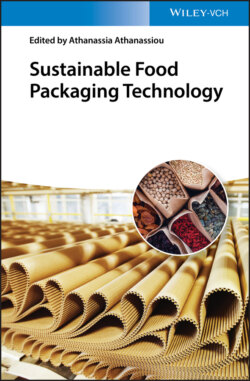Читать книгу Sustainable Food Packaging Technology - Группа авторов - Страница 16
1.3.1 Polylactide
ОглавлениеThe commercialization of PLA began in 1990 though it was known since 1845. PLA is mostly obtained from bacterial fermentation of carbohydrates that can come from renewable resources such as corn or sugar. Fermentation turns the sugar into lactic acid, which is the building block for PLA, but most industrial applications make use of its dimer lactide. NatureWorks LLC (previously Cargill Dow LLC) and, more recently, Corbion (former Purac Bioplastics) are the major suppliers of PLA with a production capacity of over 100 ktons per year, in which this biopolymer is produced in a continuous efficient synthetic process via ring‐opening polymerization (ROP) of the lactide dimer [21]. There are two optical forms: L‐lactide, the natural isomer, and D‐lactide, the synthetic one [22]. The production of the different isomers depends on the microbial strain used during the fermentation process. The polymer crystallinity and the properties of PLA can significantly vary depending on the ratio and stereochemical nature of the monomer [23].
Nowadays, PLA is one of the most researched and commercialized biopolymers and it is seen as a potential substitute for conventional polymers as packaging materials since it is bio‐based and compostable [24]. It has similar properties to traditional polymers such as PET, PS, and polycarbonate (PC) [25]. The most relevant characteristics of this biopolymer are high rigidity, good transparency, heat sealability, printability, and melt processability. Also, it can be processed on large‐scale production lines such as injection molding, blow molding, thermoforming, and extrusion [26]. It is classified as generally recognized as safe (GRAS) by the United States Food and Drug Administration (FDA) and is safe for all food packaging applications [27]. However, it also has limiting properties for its use in packaging applications. For example, its low glass transition temperature (Tg) limits its utilization above 55 °C and it also shows low toughness and ductility [28]. Nevertheless, these narrow circumstances can be improved by varying the ratio of L/D isomers, modifying its stereochemistry, or mixing with other polymers and fillers to improve the mechanical and thermomechanical properties [29].
In the field of food packaging, PLA is ideal for fresh products and those that do not require protection against oxygen, but also it can be used in food trays, bottles, candy wraps, and cups [30]. Accordingly, its high permeation to water makes it suitable for some packaging applications such as extension of the life period of fresh fruit and bread. Some coatings are used as a kind of barrier layer to reduce permeability of this biopolymer [31, 32]. Figure 1.2 shows some commercial packaging articles made of PLA to contain food products.
Figure 1.2 Commercial food packaging articles made of polylactide (PLA): (a) Coffee capsules. (b) Yogurt cups.
Source: Courtesy of Danone (Paris, France).
